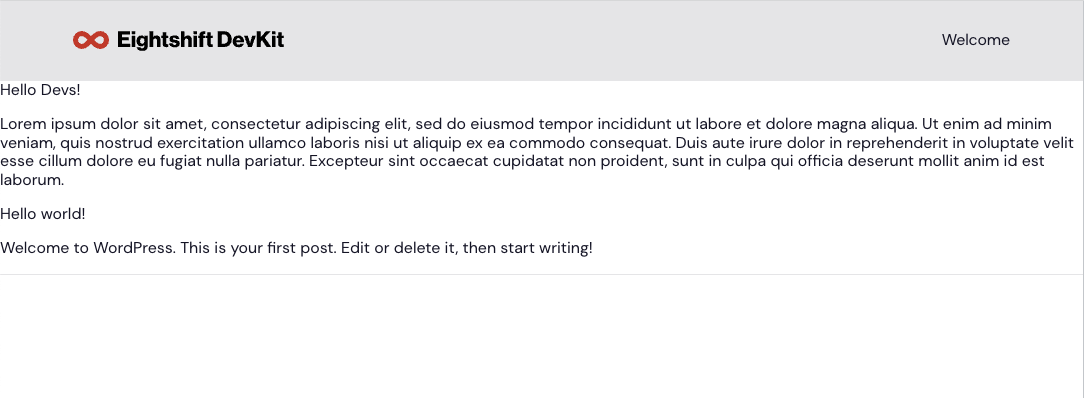How to use the Wrapper as a standalone component
As one of the most powerful features in the Eightshift DevKit, the Wrapper is a part of every Eightshift block in the Gutenberg editor, but what about WordPress templates?
Wrapper is designed to be the ultimate top-level component that controls how your block behaves in the website layout. It is a sort of a 'section' in traditional builders. By default, you can control a whole lot of stuff, but there is an option to add custom attributes and tailor the Wrapper to the needs of your project.
What are WordPress templates?
Before the days of Full Site Editing in WordPress, we used template files to add custom layouts to a blog page or post archives.
While Full-site editing (FSE) is supported in Eightshift Libs, a couple of modifications have to be done in your project to make it work.
Depending on your setup, you might still use those as they are still a core part of WordPress themes.
Usage in templates
Thanks to the Components helper, we can easily render() any component in our template.
Interested in how to use components in a block? Take a look at our docs.
For this example, we'll use index.php, as you already have it in your theme. If not, use the code below:
<?php
/**
* Display regular index/home page
*
* @package InfinumLibs
*/
use InfinumLibsVendor\EightshiftLibs\Helpers\Components;
get_header();
if (have_posts()) {
while (have_posts()) {
the_post();
the_title();
the_content();
}
}
get_footer();

And there it is, a bog-standard blog page that you can style only "the old way"... But not in our case!
Using the Wrapper component
First, let's import our Components helper class. Make sure to use the namespace from your composer.json.
use InfinumLibsVendor\EightshiftLibs\Helpers\Components;
If we look deeper into the render method, we'll see that for the $component parameter, we can pass the component's name or the full path (ending with .php). We made it simple, so use wrapper.
If you are upgrading from an older version (supported since [Libs v6.5.7] (https://github.com/infinum/eightshift-libs/releases/tag/6.5.7) and Frontend Libs v8.6.2) copy code from wrapper.php into your project.
We have two required properties to add to the Wrappers manifest.json: wrapperOnlyOutput and wrapperManualContent.
"wrapperOnlyOutput": {
"type": "boolean",
"default": false
},
"wrapperManualContent": {
"type": "string",
"default": ""
}
echo Components::render(
'wrapper',
[
'wrapperOnlyOutput' => true,
'wrapperManualContent' => '',
],
'',
true
);
Setting the $useComponentDefaults to true will save you the trouble of setting a lot of additional properties by using default values defined in your manifest.
Wrapper output
Now that we have a working Wrapper component in our template, it's time to display posts in the loop.
Let's use the Card from the Frontend Libs as it's the perfect component to display post details and pass it to the wrapperManualContent.
To make the Card component look even better, we'll use some of the powerful properties the Wrapper component has to offer and add spacing between each item.
'wrapperSpacingTopLarge' => 50,
'wrapperSpacingBottomLarge' => 50,
For the list of all available properties, look at the Wrapper's manifest.json.
Final result
<?php
/**
* Display regular index/home page
*
* @package InfinumLibs
*/
use InfinumLibsVendor\EightshiftLibs\Helpers\Components;
get_header();
if (have_posts()) {
while (have_posts()) {
the_post();
echo Components::render(
'wrapper.php',
[
'wrapperOnlyOutput' => true,
'wrapperManualContent' => Components::render('card', [
'introContent' => sprintf(__('On %1$s by %2$s', 'eightshift'), get_the_date(), get_the_author_meta('display_name')),
'headingContent' => get_the_title(),
'paragraphContent' => apply_filters('the_content', get_the_excerpt()),
'buttonContent' => __('View more', 'eightshift'),
'buttonUrl' => get_permalink(),
]),
'wrapperSpacingTopLarge' => 50,
'wrapperSpacingBottomLarge' => 50,
],
'',
true
);
}
}
get_footer();

Conclusion
Although the Wrapper is (usually) not intended to be used as a standalone component, there is a nice benefit to having a time-saving, out-of-the-box solution for displaying content in a grid already defined in your project.